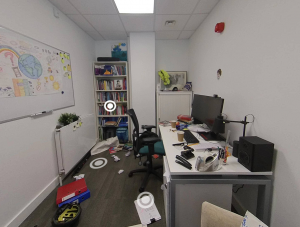Louise Oliver and her team have been working on a series of gamified learning experiences, with assistance from some of the Learning Technologists, so we took the opportunity to ask her about some of her work in this area of innovative pedagogy.
The latest concept was an immersive murder mystery learning scenario where each character in the game is a research method or related to research in some way. A funding bid is being written to explore why people commit murder. During the write up of the funding bid, Professor Quantitative is poisoned. Each character in the game has a unique motive to murder Quantitative and suspicions are high. To play the game, the learners need to work in teams to investigate whodunnit! They are given clues to take them to different places in the building where they find different materials (films, a virtual simulation of the murderer’s office and also written materials). They have quizzes, puzzles and questions to answer as they navigate the game to help consolidate their learning.
Tell us about some of the highlights of the HSS Murder Mystery experience you organised. What was the main driver behind it?
I am aware that, at times, engaging in learning about research methods can be a little dry and/or very different for some. I therefore, wanted to create a learning experience which helped the learners immerse themselves in the learning material, offering a very different way of making sense of qualitative research methods. I love a cosy murder mystery and it was not such a leap to create a game in which the different research methods and associated aspects of research (such as ethics) became living characters. I had great fun creating the story lines and associated clues, such as love letters, emails, diaries, newspaper clippings and the films. Richard Williams also created clues and puzzles which were used at each stage of the game to help consolidate learning as the game is played.
I have to say that one of the main highlights of creating and developing this game was how many people came together to make this happen. I asked Richard Williams (Senior Lecturer in Social Work) to work with me on this project. We then worked with academics across the faculty who played key characters. I worked with two of the Learning Technologists to create a virtual office scene that the learners could search as well as help me learn how to edit films and many more detailed technical work which their expertise was required for. I worked with a Programme Support Officer who is skilled in scripts and helped design one of the recorded scenes as well as a Masters Degree film student who recorded and edited much of the filmed pieces. It was wonderful how engaged everyone was in this project to make it happen. Prior to bringing this to the learners, Richard and I also ran a peer reviewed session, this was a great help as it helped not only give me confidence in what we had created but also a few aspects we could develop.
What do you feel have been the greatest benefits to students involved in these experiences? Any feedback you can share?
Following the first time this game was played with a group of Level 6 learners, the feedback was very positive. Many spoke about how fun and engaging the game was and how it brought the material to life and most importantly, that they had learnt about qualitative research methods through the game:
“It was a fun and different way to learn”
“It was very engaging and interactive; made me develop critical ways of thinking”
“Each character was given a good back story which helped me to learn more about the different types of research”
“The humour helped with engagement and made the experience enjoyable and memorable”
“It was easy to understand, very engaging and inclusive for all”
Do you feel the benefits for the staff/academics outweighs the effort invested when constructing gamified learning experiences?
It takes a lot of time and effort to make a game and for me, I always collaborate with others, and should explain that I am quite new to game-based learning and gamification. I have been learning a lot from others who have different areas of expertise which make the projects develop over time. Each game is made with the intention that they will be used by lots of people, across disciplines, therefore, the effort is always worthwhile.
What were the main challenges you faced?
I am not sure I faced challenges with this game, everyone was so willing to engage in this project, so it came together well. I would say that it took me a lot of time to write and create a lot of the work and of course people’s diaries are busy, so I had to plan in advance, but it was so much fun to create.
What’s next for you in terms of gamified learning? Do you have any ongoing or upcoming projects?
I am involved in a few projects using game-based learning. I am leading on a critical reflection board game with Dr Orlanda Harvey, Emily Rosenorn-Lanng, Stevie Corbin-Clarke and two social workers Hannah Gurr and Alice Jones. A decision-making easy print board game, with Emily Rosenorn-Lanng, Stevie Corbin-Clarke and Stefan Kleipoedszus. And my newest project is a virtual escape room with Stefan Kleipoedszus, Sam Ware, Ben Goldsmith and David Hunt.
We would like to thank Louise for her time to explore her work in this area, and if you have any interest in talking about or utilising some of the resources she has created, you can contact her using her staff profile at BU.








